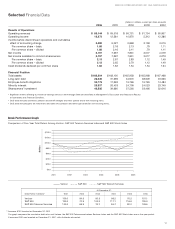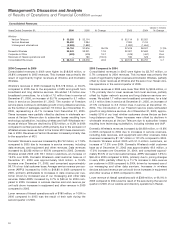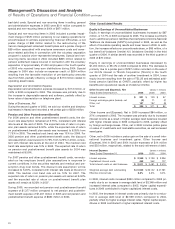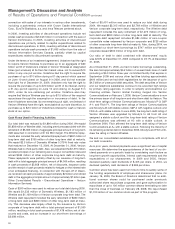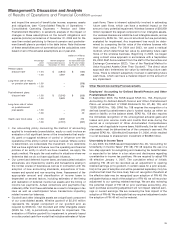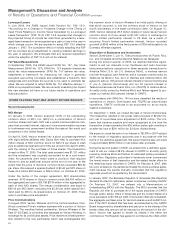Verizon Wireless 2006 Annual Report Download - page 26
Download and view the complete annual report
Please find page 26 of the 2006 Verizon Wireless annual report below. You can navigate through the pages in the report by either clicking on the pages listed below, or by using the keyword search tool below to find specific information within the annual report.
24
SEGMENT RESULTS OF OPERATIONS
On November 17, 2006, we completed the spin-off to our shareowners
of our U.S. print and Internet yellow pages directories, which was
included in the Information Services segment. The spin-off resulted in
a new company, named Idearc Inc. In addition, on April 2, 2006, we
reached definitive agreements to sell our interests in TELPRI and
Verizon Dominicana, each of which was included in the International
segment. In accordance with SFAS No. 144, we have classified the
results of operations for our U.S. print and Internet yellow pages direc-
tories business, Verizon Dominicana and TELPRI as discontinued
operations and assets held for sale. Accordingly, we now have two
reportable segments and prior period amounts and discussions are
revised to reflect this change. Our segments are Wireline and Domestic
Wireless. You can find additional information about our segments in
Note 17 to the consolidated financial statements.
We measure and evaluate our reportable segments based on segment
income. Corporate, eliminations and other includes unallocated cor-
porate expenses, intersegment eliminations recorded in consolidation,
the results of other businesses such as our investments in unconsoli-
dated businesses, primarily Omnitel and CANTV, lease financing, and
asset impairments and expenses that are not allocated in assessing
segment performance due to their non-recurring nature. These adjust-
ments include transactions that the chief operating decision makers
exclude in assessing business unit performance due primarily to their
non-recurring and/or non-operational nature. Although such transac-
tions are excluded from the business segment results, they are
included in reported consolidated earnings. Gains and losses that are
not individually significant are included in all segment results, since
these items are included in the chief operating decision makers’
assessment of unit performance.
Wireline
The Wireline segment, which includes the operations of the former
MCI, consists of the operations of Verizon Telecom, a provider of
telephone services, including voice, broadband video and data, net-
work access, long distance, and other services to consumer and
small business customers and carriers, and Verizon Business, a
provider of next-generation IP network services globally to medium
and large businesses and government customers. As discussed ear-
lier under “Consolidated Results of Operations,” in the second
quarter of 2005, we sold wireline properties in Hawaii representing
approximately 700,000 access lines or 1% of the total Verizon
Telecom switched access lines in service. For comparability pur-
poses, the results of operations shown in the tables below exclude
the Hawaii properties that have been sold.
Operating Revenues (dollars in millions)
Years Ended December 31, 2006 2005 2004
Verizon Telecom
Mass Markets $22,528 $20,446 $ 20,447
Wholesale 8,323 9,075 9,128
Other 2,408 2,593 2,686
Verizon Business
Enterprise Business 13,999 6,018 6,196
Wholesale 3,381 1,376 1,218
International and Other 3,110 ––
Intrasegment Eliminations (2,955) (1,892) (1,654)
Total Wireline Operating Revenues $50,794 $37,616 $ 38,021
In connection with the completion of the MCI merger, our product
lines were realigned to be reflective of the Line of Business structure
in which the product lines are currently being managed. Prior period
amounts and discussions were reclassified to conform to the current
presentation.
Verizon Telecom
Mass Markets
Verizon Telecom’s Mass Markets revenue includes local exchange
(basic service and end-user access), value-added services, long dis-
tance, broadband services for residential and certain small business
accounts and FiOS TV services. Value-added services are a family of
services that expand the utilization of the network, including products
such as Caller ID, Call Waiting, Home Voicemail and Return Call.
Long distance includes both regional toll services and long distance
services. Broadband services include DSL and FiOS.
Our Mass Market revenues increased by $2,082 million, or 10.2% in
2006, and decreased by $1 million, or 0.0% in 2005. The increase in
2006 was principally due to the inclusion of revenues from the
former MCI and, in 2006 and 2005, growth from broadband and long
distance. In both years revenue increases were offset by lower
demand and usage of our basic local exchange and accompanying
services attributable to subscriber losses due to technology substi-
tution, including wireless and VoIP.
We added 1,838,000 new broadband connections, including
517,000 for FiOS in 2006, for a total of 6,982,000 lines at December
31, 2006, an increase of 35.7% compared to 5,144,000 lines in
service at December 31, 2005. We have achieved a FiOS data pen-
etration rate of 14% across all markets where we have been selling
this service. Our Freedom service plans continue to stimulate growth
in long distance services, as the number of plans reached 7.9 million
as of December 31, 2006, representing a 44.1% increase from
December 31, 2005. As of December 31, 2006, approximately 58%
of our legacy Verizon wireline customers have chosen Verizon as
their long distance carrier.
Declines in switched access lines in service of 7.6% in 2006 and 6.7%
in 2005 were mainly driven by the effects of competition and tech-
nology substitution. Demand for legacy Verizon residential access
lines declined 7.1% in 2006 and 6.3% in 2005, as customers substi-
tuted wireless, broadband and cable services for traditional landline
services. At the same time, legacy Verizon business access lines
declined 3.2% in 2006, and 4.2% in 2005, primarily reflecting compe-
tition and a shift to high-speed, high-volume special access lines.
We continue to seek opportunities to retain and win back customers.
Our Freedom service plans offer local services with various combi-
nations of long distance and Internet access services in a
discounted bundle available on one bill. We have introduced our
Freedom service plans in nearly all of our key markets.
Wholesale
Wholesale revenues are earned from long distance and other com-
peting carriers who use our local exchange facilities to provide
usage services to their customers. Switched access revenues are
derived from fixed and usage-based charges paid by carriers for
access to our local network. Special access revenues originate from
carriers that buy dedicated local exchange capacity to support their
private networks. Wholesale services also include local wholesale
revenues from unbundled network elements (UNEs), interconnection
revenues from CLECs and wireless carriers, and some data trans-
port revenues.
Management’s Discussion and Analysis
of Results of Operations and Financial Condition continued





